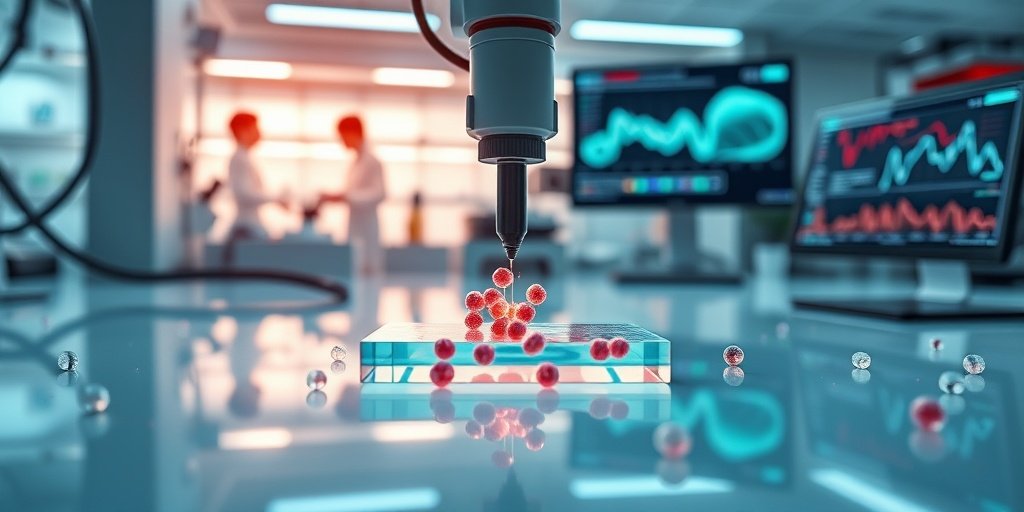⚡ Quick Summary
The article discusses the transformative role of nanomotion sensors in microbiology and biology, highlighting their ability to provide label-free detection of biological activity. These sensors leverage advances in nanotechnology and artificial intelligence to enhance diagnostics and research methodologies.
🔍 Key Details
- 📊 Technologies: Atomic Force Microscopy, optical nanomotion detection, graphene drum sensors, optical fiber-based sensors
- 🔬 Applications: Diagnostics, therapeutics, fundamental biological research
- 🤖 Integration: Advanced modeling, artificial intelligence, and machine learning for data analysis
- 💰 Cost-effectiveness: Unique advantages in sensitivity and applicability
🔑 Key Takeaways
- 🌟 Nanomotion sensors are pivotal in detecting biological interactions.
- 🔍 Label-free detection allows for real-time monitoring of metabolic activities.
- ⚙️ Diverse methodologies enhance the versatility of applications in various fields.
- 📈 AI and machine learning improve the analysis of complex nanomotion data.
- 🌍 Potential to revolutionize diagnostics and therapeutic strategies in healthcare.
- 🔬 Research advancements are continuously expanding the capabilities of these sensors.
- 💡 Cost-effective solutions are emerging from these technologies, making them accessible.

📚 Background
The field of microbiology and biology has seen significant advancements with the introduction of nanomotion sensors. These sensors capitalize on the inherent nanoscale movements of living organisms, which are direct indicators of their metabolic activities. The evolution of these technologies has opened new avenues for research and diagnostics, moving beyond traditional methods that often require labeling and extensive preparation.
🗒️ Study
The review article by Girasole and Longo provides a comprehensive overview of the evolution and applications of nanomotion sensing. It discusses various methodologies, including Atomic Force Microscopy-based sensors and optical detection techniques, emphasizing their unique advantages in sensitivity and cost. The integration of advanced modeling and AI further enhances the capabilities of these sensors, allowing for more sophisticated data analysis.
📈 Results
The findings indicate that nanomotion sensors can effectively convert nanoscale movements into measurable signals, providing insights into biological interactions without the need for labels. This capability not only improves the sensitivity of detection but also allows for real-time monitoring, which is crucial for understanding complex biological processes.
🌍 Impact and Implications
The implications of this research are profound. By utilizing nanomotion sensors, researchers and clinicians can achieve more accurate diagnostics and therapeutic interventions. The ability to monitor biological activities in real-time could lead to significant advancements in personalized medicine and the development of targeted therapies, ultimately improving patient outcomes and advancing our understanding of biological systems.
🔮 Conclusion
The review highlights the transformative potential of nanomotion sensors in the fields of microbiology and biology. As these technologies continue to evolve, they promise to enhance our capabilities in diagnostics and research, paving the way for innovative solutions in healthcare. Continued exploration and investment in this area are essential for unlocking the full potential of these groundbreaking tools.
💬 Your comments
What are your thoughts on the advancements in nanomotion sensing? How do you see these technologies impacting the future of biology and medicine? 💬 Join the conversation in the comments below or connect with us on social media:
The Burgeoning Importance of Nanomotion Sensors in Microbiology and Biology.
Abstract
Nanomotion sensors have emerged as a pivotal technology in microbiology and biology, leveraging advances in nanotechnology, microelectronics, and optics to provide a highly sensitive, label-free detection of biological activity and interactions. These sensors were first limited to nanomechanical oscillators like atomic force microscopy cantilevers, but now they are expanding into new, more intriguing setups. The idea is to convert the inherent nanoscale movements of living organisms-a direct manifestation of their metabolic activity-into measurable signals. This review highlights the evolution and diverse applications of nanomotion sensing. Key methodologies include Atomic Force Microscopy-based sensors, optical nanomotion detection, graphene drum sensors, and optical fiber-based sensors, each offering unique advantages in sensitivity, cost, and applicability. The analysis of complex nanomotion data is increasingly supported by advanced modeling and the integration of artificial intelligence and machine learning, enhancing pattern recognition and automation. The versatility and real-time, label-free nature of nanomotion sensing position it as a transformative tool that could revolutionize diagnostics, therapeutics, and fundamental biological research.
Author: [‘Girasole M’, ‘Longo G’]
Journal: Biosensors (Basel)
Citation: Girasole M and Longo G. The Burgeoning Importance of Nanomotion Sensors in Microbiology and Biology. The Burgeoning Importance of Nanomotion Sensors in Microbiology and Biology. 2025; 15:(unknown pages). doi: 10.3390/bios15070455